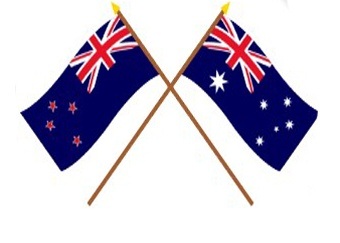The Trans-Tasman Spat Show: New Zealand-Australian Tensions

It was an awkward moment for Australia’s foreign minister, Julie Bishop. News had arrived that a New Zealand government had been formed after a lengthy period of deliberation. (The election took place on September 23.)
Veteran maverick and occasional political suicide Winston Peters of the New Zealand First party had played the familiar role of kingmaker, picking the New Zealand Labour party to form government. The 37 year old leader, Jacinda Ardern, was evidently too good to fob off.
This placed the Australian government in a prize pickle. Australian ministers had more or less designated the NZ Labour party persona non grata after questions were asked, in the NZ parliament, about matters of that country’s citizenship.
These queries all seemed provincial and inconsequential, but had potential consequences for Australia’s own deputy prime minister, Barnaby Joyce. Joyce, it seemed, had been a New Zealand citizen when elected to the Australian parliament, thereby rendering him ineligible to sit. (The High Court will, in time, rule on that point.)
Ardern had her own description of the events.
“Yes, someone from the ALP put some legal question to [NZ Labour frontbencher Chris Hipkins] around citizenship. No mention was made of anyone’s name, no rationale for any particular case being pursued was ever raised.”
Bishop proceeded to have a distinctly anti-diplomatic meltdown. Culprits were needed, scalps sought.
“New Zealand is facing an election. Should there be a change of government, I would find it very difficult to build trust with those involved in allegations designed to undermine the government of Australia.”[1]
This was particularly so given that “members of a political party […] had been used by the Australian Labor Party to seek to undermine the Australian government.”
Ardern was left puzzled, offering to placate the indignant, glacial Bishop.
“I will not let false claims stand in the way of that relationship.”
She would have called the irate Australian foreign minister to chat about matters, but did not have her personal number.
Australian prime minister, Malcolm Turnbull, offered an analysis that was not much better. The issue was less with Ardern than the conduct of the Australian Labor Party, filled with its fifth columnist apparatchiks. Its leader, Bill Shorten, had been “willing to interfere in the political system of a foreign country.” Shorten was no less than a conspiratorial thief hoping to, in Turnbull’s words, “steal government” in collusion with “a foreign power”. Foreign, conspiracy, stealing – all words fashioned from the modern news desk of insurgent politics and cock-eyed fantasy.
It was difficult, then, to reconcile this language of hyperventilating insurgency, subversion and Putin-like destabilisation with the prospect of an Ardern government. Much egg had to be washed from the face.
Turnbull took to Twitter to congratulate the new plotting leader, claiming to look forward to “building on our two nations’ great partnership.” At a Friday morning press conference, the questions pushed and prodded: How would Bishop cope with this enemy entity across the Tasman? The minister had crept rather gingerly into a more diplomatic shell. The relationship between the countries was strong.
Much of this will pass, leaving its characteristic bitter residue. The relationship between these two countries has tended to be a matter of sibling consternation and rhetorical friendship. New Zealand tends to have been far more realistic than its enormous neighbour, keeping out of militarist games while focusing on being, at points, a good international citizen.
Both countries have also produced their fair share of misplaced, provincial smugness. Former New Zealand prime minister, Robert Muldoon, famously claimed that his country’s “emigration to Australia raises the IQ in both countries.”
The same prime minister was livid at the unsportsmanlike approach taken by the Australian cricket team in a 1981 one-day international match that still haunts its participants. After the Australian bowler, Trevor Chappell, was asked by captain and brother Greg to deliver the last delivery as an underarm, Muldoon deemed it “an act of cowardice appropriate to a team playing in yellow.”
A persistent theme, in fact, emerges: the leaders of New Zealand and Australia have often disliked each other. Muldoon had little time for his counterpart in Canberra, Malcolm Fraser. Australia’s longest serving Labor prime minister, Bob Hawke, could barely stomach David Lange.
Lange, in turn, thought Hawke crude and cloyingly trapped by the language of masculinity.
“His language was frequently obscene and he was steeped in the culture of mateship, which for me was never a good starting point.”[2]
Even beyond the point of personalities, Lange’s explicit renunciation of the US nuclear deterrent threatened the ANZUS alliance and drove Hawke, an unabashed fan of the United States, to distraction.
Things become rather touchy with the rejection by the Lange government of a proposed visit by the USS Buchanan in February 1985. US officials refused to answer queries put to them as to whether the warship had a nuclear capability.
“Whatever the truth of its armaments,” asserted Lange, “its arrival in New Zealand would be seen as a surrender by the government.”[3]
US Secretary of State George Schultz retaliated by suspending ANZUS links and security assurances.
An Ardern-Turnbull relationship, to that end, will conform to cosmetics, keep up appearances and utter the necessary platitudes international, and often fictional friendships, thrive on. The rest of the time will be spent diligently ignoring each other.
Dr. Binoy Kampmark was a Commonwealth Scholar at Selwyn College, Cambridge. He lectures at RMIT University, Melbourne. Email: [email protected]
Notes

